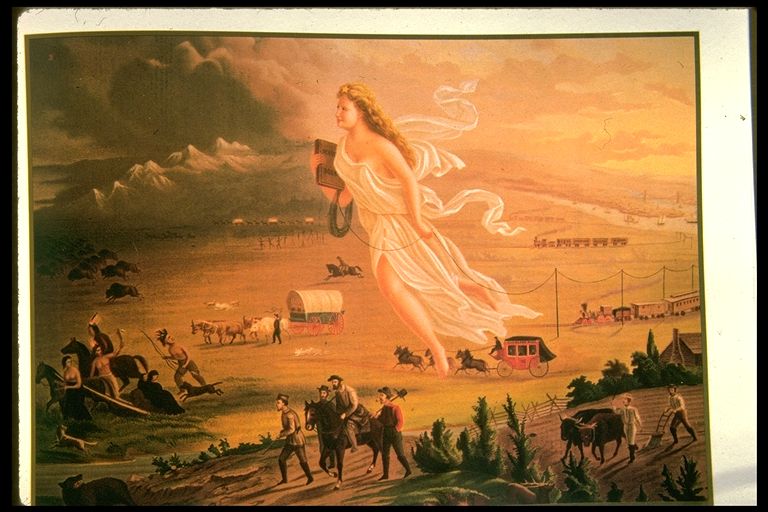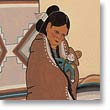
History 2710 MacKay
The West and the Life of the Nation

In John Gast's "American Progress," (1872) a diaphanously and precarious clad America floats westward thru the air with the "Star of Empire" on her forehead. She has left the cities of the east behind, and the wide Mississippi, and still her course is westward. In her right hand she carries a school book - testimonial of the national enlightenment, while with her left she trails the slender wires of the telegraph that will bind the nation. Fleeing her approach are Indians, buffalo, wild horses, bears and other game, disappearing into the storm and waves of the Pacific coast. They flee the wonderous vision - the star "is too much for them." - George Crofutt (a contemporary of Gast, who engraved and distributed this painting widely)

 This
1946 watercolor "Land of Enchantment" by Woody Crumbo (1912-1989) is a wry
comment on the confrontations of people in the twentieth century West. Woody
Crumbo was born in Lexington, Oklahoma, in 1912. A Creek-Potawatomi Indian,
Crumbo specialized in Indian figure and animal paintings. He was also an
accomplished silversmith, and was an assistant director of the El Paso Museum in
Texas.
This
1946 watercolor "Land of Enchantment" by Woody Crumbo (1912-1989) is a wry
comment on the confrontations of people in the twentieth century West. Woody
Crumbo was born in Lexington, Oklahoma, in 1912. A Creek-Potawatomi Indian,
Crumbo specialized in Indian figure and animal paintings. He was also an
accomplished silversmith, and was an assistant director of the El Paso Museum in
Texas.
The "New Western historians" propose that the West should be understood as a region: one already endowed with distinctive Indian and Hispanic cultures. It became a region where racial tensions and discriminations, extractive industries, highly urban settlements and a common dependence on the federal government were at least as important as the traditional elements we associate with a rural and independent West.
The “New Western History” has four basic points:
A) First, the West as a place, not the frontier as a process, should be our focus. “The term ‘frontier’ is nationalistic and often racist (in essence, the area where white people get scarce). The history of European advance across North America is better expressed by invasion, conquest, colonization, exploitation, development, [and] expansion of the world market.”
B) The second point follows: whatever it was that happened, it involved the convergence of diverse people—women as well as men, Indians, Europeans, Latin Americans, Asians, Afro-Americans. . . with each other and with the natural environment. The interaction of all these groups, whether in competition or cooperation, is the important thing. “The West was not where we escaped each other, but where we all met.”
C) Third point: the interaction has continued and is still happening. The “frontier” did not end in 1890, as Turner claimed; another hundred years of rich western history has followed, and it demands historians’ attention.
D) Fourth, the western story is neither one of triumph over adversity, with the resulting ennoblement of the American character, nor a unique and exceptional subjugation of an empty land (for Indians were virtually invisible in the traditional story except as enemies who resisted the inevitable). Rather, it is a great moral ambiguity. “In western American history, heroism and villainy, virtue and vice, and nobility and shoddiness appear in roughly the same proportions as they appear in any other subject of human history. . . . This is only disillusioning to those who have come to depend on illusions.”
Reading:
Recommended Reading: Don't Know Much: 262-263
Discussion topics:
Project #2: Choose one of the following topics: